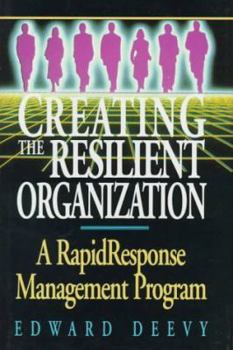Creating the Resilient Organization: A Rapid Response Management Program
The first book to offer "how-to" guidance on installing high-performance "rapid response" organizations. Forward-thinking executives will find hands-on, step-by-step guidelines for implementing the... This description may be from another edition of this product.
Format:Hardcover
Language:English
ISBN:0131696246
ISBN13:9780131696242
Release Date:January 1995
Publisher:Simon & Schuster
Length:256 Pages
Weight:1.50 lbs.
Dimensions:1.1" x 6.3" x 9.3"
Customer Reviews
2 ratings
Everyone can profit from reading this book
Published by Thriftbooks.com User , 21 years ago
For me the words 'resilient organization' conjured up the image of an organization that would be able to absorb shocks without permanent injury, and able to adapt to a rapidly changing external environment in a quick and efficient manner. In today's world, resiliency well might be the key to survival as we know that each year a wild card - a low probability event which nevertheless occurs - will probably hit us from behind. We know that even if we have the best planners helping us, it is just not practical to budget for anything but the highest probability wild cards. In which case we need to be resilient like a boxer weaving in and out seeking the weaknesses in the opposition and ready to slam home a winning blow the moment he drops his guard. If indeed that is what the author meant by creating the resilient organization I would certainly like my organization to be resilient. The fly sheet of the book had some complimentary remarks by well-known writers such as "We must abandon our outdated management systems, style and beliefs. But How? ..." and "The social contract between corporation and worker has unraveled. Loyalty has disappeared. How do you motivate employees who are little more than mercenaries?" and "In the future, there will be two types of organizations: those that are agile and responsive and those that will be swallowed up in an avalanche of change." and "'Creating the Resilient Organization' provides practical tools and proven methods for creating the agile, flexible enterprises necessary to survive and prosper." These comments made me feel that this book could have considerable value for my organization. Pointing out that the latest management fads such as TQM have failed because they do not address the core processes involved in transforming yesterday's bureaucratic organization into tomorrows responsive enterprise, Deevy makes the case for radical transformation by answering three questions:- What is it about traditional work organizations that limits their ability to be competitive in a fast-paced business environment?- What cultural or systemic changes must be made in order to regain competitiveness?- How can we most effectively transform older bureaucracies into responsive high-performing enterprises?The first three chapters deal with the first question while the remaining 14 chapters deal with the three secrets of treating employees; creating the resilient organization; leadership and middle management; the "Blitz" strategy for change; building support for change; promoting innovation and strategy; and unleashing the entrepreneurial spirit.Having taken to heart Covey's advice to "Start with the end in mind", I turned to chapter 7 with the subtitle "Begin with a vision for the future" with its opening remark from a hard-nosed business man: "This vision stuff is not going to add to the bottom line" and the author's comment "Ask any business leader what his or her vision is for the future of the company and you are likely to g
A process that works in turning older companies around.
Published by Thriftbooks.com User , 26 years ago
When I read this common sense approach in what it would take to turn an establish company around. I thought, that their was finally someone who understood the human side of organizations. That all the intellectual knowledge, was not sufficient in dealing with real people in real jobs. A very practical real life insight in dealing with companies who have a long history of mistrust of management. That the 3 stages to this process, was so simple, yet offen not seen by top management. I think perhaps that it is painfully for them to really listen to what their workers are saying. That a lot of managers are more committed in keeping their power than risk empowering their work force, for the fear of losing control. Which very act suppress the creative juices and brain power of their organizations.





